Last Halloween, I watched my 8-year-old nephew beg for “just one more scary story” while simultaneously hiding behind a pillow. Sound familiar? That’s when I realized kids have this amazing ability to crave the very thing that scares them – as long as it’s the right kind of scary.
Here’s what I’ve noticed from talking to parents and teachers: kids absolutely love haunted houses and spooky stories, but they want them served up with a good dose of humor. According to research from Spooky Middle Grade, this combination of thrills and giggles actually gets kids more excited about reading. And honestly, who doesn’t want that?
The trick is finding stories that give them goosebumps without causing those dreaded 3 AM “but what if monsters are real?” conversations. Trust me, I’ve been there.

Table of Contents
-
How to Pick Stories That Won’t Backfire
-
Friendly Monsters That Actually Teach Something
-
Mystery Adventures for Little Detectives
-
Magical Stories That Build Courage
-
Stories That Make Kids Think (Without Freaking Them Out)
-
Sci-Fi Scares That Sneak in Some Learning
-
Spooky Tales from Around the World
-
My Simple Test for Any Scary Story
-
Creating Custom Stories When You’re Out of Ideas
TL;DR
-
The best scary stories for kids build confidence while delivering just enough thrills to keep them turning pages
-
Different ages need different scare levels – what works for a 5-year-old will bore a 10-year-old
-
Look for stories where kids solve problems through friendship, creativity, and courage rather than luck
-
Skip anything with real-world dangers – stick to silly monsters, friendly ghosts, and magical mysteries
-
When in doubt, read it yourself first (I know, who has time? But it’s worth it)
-
The goal isn’t perfect – it’s keeping them curious and excited about reading
-
Modern kids deserve stories with diverse characters and different cultural perspectives on the supernatural
How to Pick Stories That Won’t Backfire
You know that moment when your kid asks for a scary story, then immediately says “but not TOO scary”? Yeah, we’ve all been there. It’s like walking a tightrope between “this is boring” and “I’m never sleeping again.”
I’ll be honest – I’ve definitely picked the wrong book before. Nothing like a story about a “friendly” monster that had my daughter checking under her bed for weeks. Live and learn, right?
The best scary stories for kids work because they create just enough tension to keep young readers engaged without overwhelming them. Think of it like a gentle roller coaster – lots of “whee!” moments but you always feel safe.
Getting the Scare Level Just Right
Here’s the deal: 4-7 year olds need silly monsters that make them giggle more than gasp. Think monsters who are afraid of dust bunnies or ghosts who can’t remember where they put their “boo.”
Kids 8-10 can handle a bit more mystery – maybe a spooky house that turns out to be home to a lonely old cat, or strange noises that lead to discovering a family of raccoons having midnight dance parties.
And your 11-12 year olds? They’re ready for some real detective work and mysteries they can actually solve alongside the characters.
When you’re trying to figure out what works for your kid, bedtime stories for kids can give you a good baseline for understanding what themes and intensity levels click with different ages.
Pro tip: Read it yourself first. I know, I know – who has time? But trust me, five minutes of preview reading can save you from those middle-of-the-night monster conversations.
Stories That Actually Teach Something
The really great scary stories sneak in life lessons without feeling like a lecture. Your kids should come away feeling braver, not more worried about the world.
Look for stories where characters solve problems through friendship, creativity, and courage. When the vampire learns to overcome his fear of the dark to help others, or when kids work together to solve a mystery, that’s the good stuff. Those are the stories that stick with kids in the best possible way.
Take “The Monster at the End of This Book” by Jon Stone – it builds genuine suspense as Grover begs you not to turn pages, but the payoff shows kids that their fears are often way bigger than reality. Plus, they get to feel clever for “helping” Grover face his worry.
Keeping Everyone Safe and Sound
Look, here’s my foolproof test: If you’re reading it and thinking “this might give ME nightmares,” it’s probably too much for your kid. And if you find yourself laughing or feeling good about how it ends, you’ve probably found a winner.
Stay away from anything that feels too real – no home invasions, kidnapping, or violence that could actually happen. Stick with magical problems that need magical solutions. Kids are smart enough to know the difference between fantasy fears and real-world dangers.
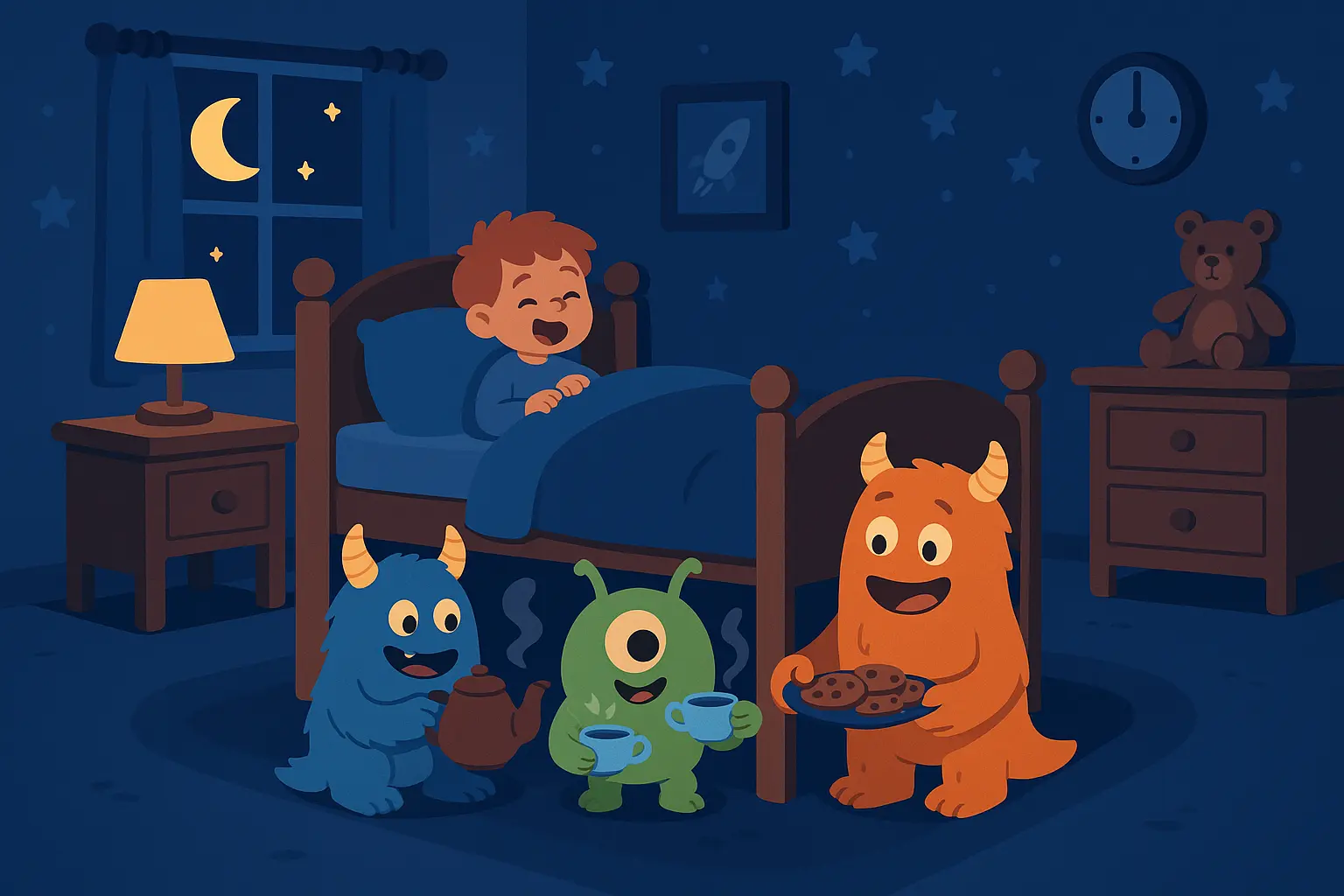
Friendly Monsters That Actually Teach Something
The best monster stories flip the script completely – instead of scary creatures, you get misunderstood characters who just need a friend. These work especially well for kids 6-10 who are starting to understand that appearances can be deceiving.
These reimagined monster tales remind me of classic folktale story examples that have been teaching kids important lessons for centuries – just with a modern, less scary twist.
1. The Friendly Vampire’s Midnight Adventure
Picture this: a vampire kid who’s absolutely terrified of the dark. I know, I know – it’s like a fish being afraid of water! But that’s exactly why kids love this story. When he has to brave the darkness to help some lost kids find their way home during a power outage, your little ones will be cheering him on.
The whole story is about how courage isn’t the absence of fear – it’s doing the right thing even when you’re scared. And honestly, isn’t that a lesson we all need reminding of sometimes?
2. The Werewolf Who Couldn’t Howl
Luna’s family are all werewolves, but when she transforms, she’s completely silent. Her pack thinks something’s wrong with her until her quiet nature helps her hear faint calls for help from lost hikers during a thunderstorm.
I love this one because it shows kids that being different isn’t being broken. Sometimes your “weird” trait is exactly what makes you special. Plus, it sneaks in some basic sign language and teaches kids to pay attention to non-verbal communication.
3. The Ghost Who Lost His Boo
I read this one to my neighbor’s kids last month, and they spent the next hour practicing different “boo” sounds to help ghosts who might have the same problem. It’s that kind of story that sticks with them in the best way.
Whisper the ghost wakes up one day unable to make his signature sound, and two kids decide to help him find his missing “boo.” It’s all about communication, problem-solving, and how everyone expresses themselves differently.
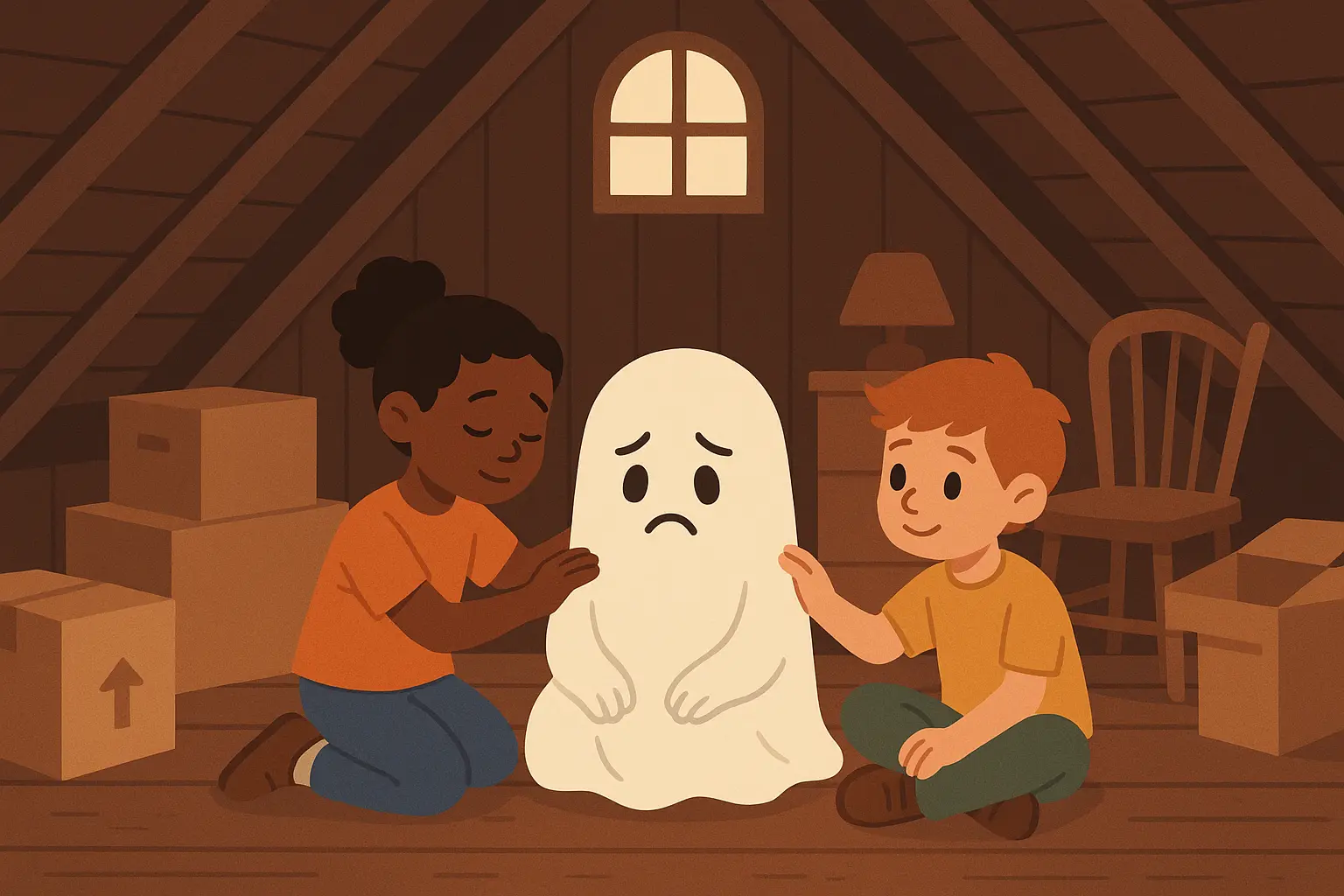
4. Frankenstein’s Monster Learns to Garden
This one completely turns the scary monster trope on its head. The monster discovers he has a green thumb and loves nurturing plants, teaching kids not to judge by appearances. When the community sees him gently caring for flowers, they realize he’s got the kindest heart of anyone.
It’s a great way to sneak in some basic plant science while teaching kids about giving people second chances and looking beyond the surface.
5. The Mummy’s Lost Bandages
An ancient mummy’s bandages start unraveling at the worst possible moment, and forest animals pitch in to help rewrap him before an important ceremony. It sounds ridiculous, and it is – in the best way possible.
Kids learn about ancient Egypt while getting a good laugh about embarrassing moments we’ve all had. Plus, it shows how communities come together to help when someone’s having a rough day.
Mystery Adventures for Little Detectives
Mystery stories are perfect for kids 7-12 who love puzzles and want to feel smart. The best ones let kids solve clues right alongside the characters, making them feel like real detectives rather than just passive readers.
6. The Case of the Disappearing Halloween Candy
Young detectives track down mysteriously vanishing treats throughout their neighborhood. Spoiler alert: it’s a family of hungry raccoons who’ve figured out how to “borrow” candy from porches.
The resolution is all about sharing and coexisting with wildlife – plus kids get to practice observation skills and logical thinking. My friend’s daughter became obsessed with tracking animal behavior in their backyard after reading this one.
7. The Haunted Library Mystery
Strange after-hours noises in the school library lead to a group investigation. Turns out it’s the lonely night custodian who misses storytelling and has been practicing reading aloud to empty chairs.
This one hits right in the feels while teaching kids about loneliness and community building. The best part? The solution involves organizing storytelling events that bring everyone together.
8. The Secret of Whispering Woods
Friends investigate eerie sounds coming from the local forest using careful observation and scientific thinking. They discover it’s an injured owl whose calls sound different from normal owl sounds.
It’s a great introduction to bird watching and animal behavior, plus it teaches kids that most “mysterious” things have perfectly logical explanations once you investigate properly.

9. The Phantom of the School Play
Students work together to figure out who’s been sabotaging their theater production. The mystery reveals a classmate who felt left out and was acting up because of jealousy.
This one’s brilliant for teaching conflict resolution and inclusion. Instead of punishment, the solution involves bringing the “phantom” into the production and addressing the real problem – feeling excluded.
10. The Mystery of the Glowing Cave
Adventure-seeking kids explore a mysterious cave with strange lights, using safety precautions and scientific thinking. They discover naturally fluorescent crystals and learn about protecting natural wonders.
It combines mystery-solving with geology lessons, and the emphasis on exploring safely gives parents some peace of mind when their kids inevitably want to go on their own adventures.
Magical Stories That Build Courage
Supernatural adventures for kids 8-12 open up whole new worlds while keeping things clearly in the realm of fantasy. These stories encourage wonder and curiosity while showing kids they’re braver than they think.
These magical adventures often use similar adventure story elements that combine fantastical themes with real character growth and important life lessons.
11. The Time-Traveling Halloween Night
Kids accidentally travel through different Halloween celebrations throughout history after touching an ancient jack-o’-lantern. They experience everything from medieval harvest festivals to Victorian séances while trying to find their way back home.
It’s like a history lesson disguised as an adventure story. Kids learn about how traditions evolve while getting to experience different time periods firsthand.
12. The Witch’s Apprentice Academy
Ten-year-old Marcus gets accepted to Moonbridge Academy for Unusual Arts, but his magic always goes sideways in unexpected ways. Eventually, he discovers that his “chaos magic” is actually incredibly rare and perfect for solving complex problems.
This story is fantastic for kids who feel different or struggle in traditional learning environments. It shows how what seems like a problem can actually be your greatest strength.
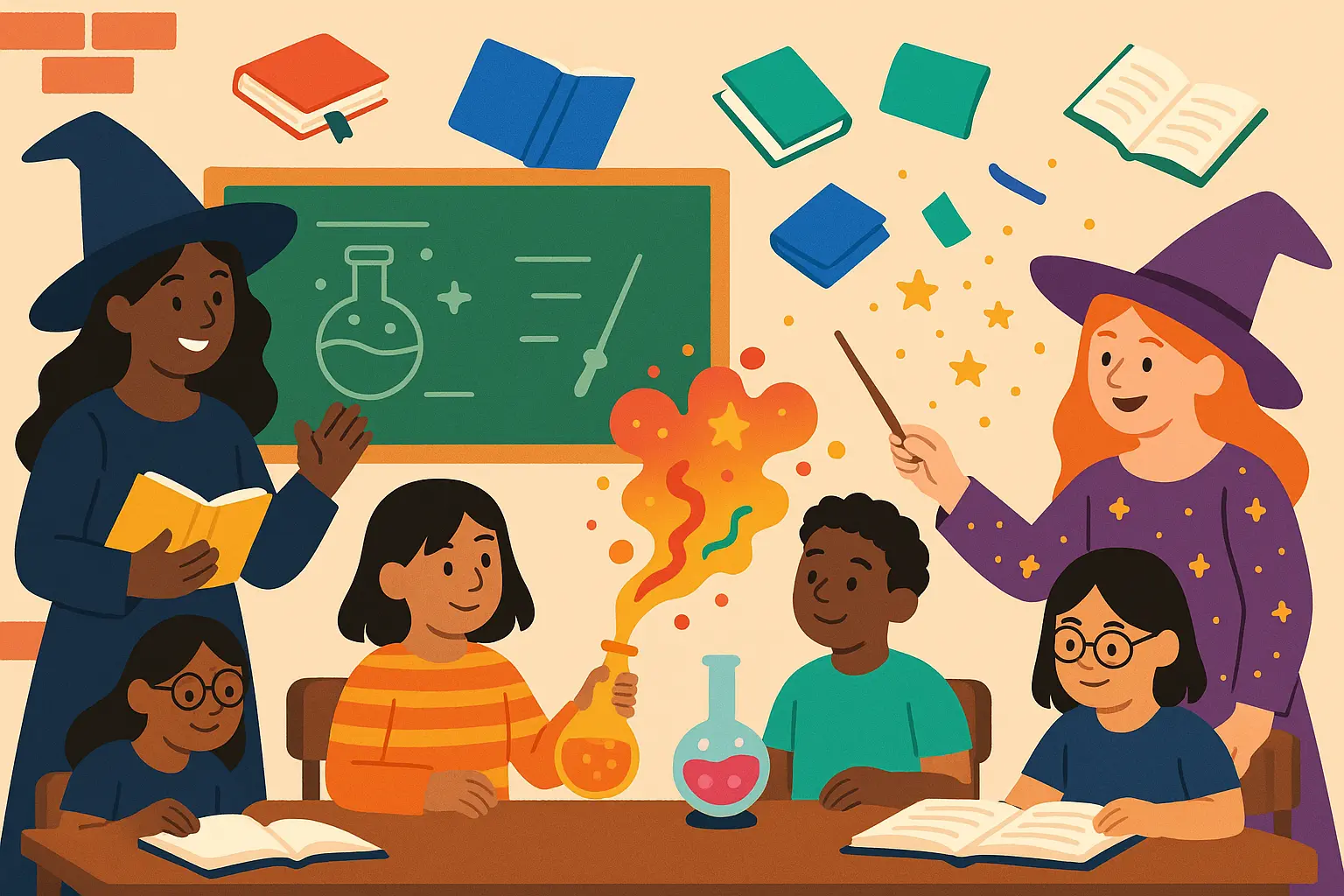
13. The Dragon Who Was Afraid of Fire
A young dragon is terrified of his own fire-breathing abilities until understanding friends help him realize his cooler flames are perfect for warming homes without burning them down.
It’s all about self-acceptance and finding supportive friendships. Kids learn that everyone has unique abilities that become strengths when properly understood and appreciated.
14. The Enchanted Carnival After Dark
Children discover a magical carnival that only appears at midnight, featuring rides powered by laughter and games that reward kindness rather than skill. They have to solve puzzles and help other visitors to earn their way through.
This one’s pure magic and wonder – the kind of story that makes kids look for hidden doors and secret passages in their own neighborhoods.
15. The Guardian Spirits of the Old Oak Tree
Kids befriend protective spirits who guard their neighborhood from a massive old oak tree. When developers threaten to cut it down, the children must find creative ways to protect both their spirit friends and the natural habitat.
It teaches environmental stewardship and community activism while showing kids they have the power to make a difference when they care about something important.
Stories That Make Kids Think (Without Freaking Them Out)
These stories for kids 9-12 introduce more complex ideas while keeping everything age-appropriate. They challenge young readers to think critically about choices, reality, and consequences through safe, fantastical scenarios.
16. The House That Changed Its Mind
A family moves into a house that rearranges its rooms based on everyone’s emotions and needs. Initially frustrating, they learn to communicate with their home and discover it’s actually trying to help them adapt to their new life.
This one’s great for families dealing with big changes like moves or transitions. It teaches adaptation and family communication while being genuinely fun and imaginative.
17. The Mirror That Showed Tomorrow
Children discover a school mirror that reveals possible futures based on choices they’re considering. They learn to use this power responsibly while understanding that their actions can change outcomes.
It’s a fantastic way to teach decision-making skills and personal responsibility without being preachy. Kids love the “what if” scenarios, and parents love the life lessons.
18. The Invisible Friend Dilemma
A child’s imaginary friend becomes increasingly demanding and starts interfering with real relationships. The story explores healthy imagination versus escapism while teaching about social development.
This one handles the delicate topic of imaginary friends really well, helping kids understand the difference between fantasy and reality in their emotional lives.
19. The Memory Collector
Kids investigate why people in their town are forgetting important family stories. They discover a lonely spirit who lost their own memories centuries ago and has been trying to experience remembrance through others.
It teaches about the value of family history and oral traditions while showing how sharing memories strengthens rather than weakens them. Plus, it’s a gentle introduction to concepts about loneliness and community healing.
20. The Dream Weaver’s Apprentice
A young person learns to control nightmares by entering the dream world as an apprentice. They discover that facing fears directly in dreams can help overcome anxieties in waking life.
This one actually teaches practical anxiety management techniques while being a genuinely engaging fantasy adventure. It’s like therapy disguised as a fun story.
Sci-Fi Scares That Sneak in Some Learning
Science fiction stories for kids 8-12 combine future technology with gentle thrills while sneaking in STEM education. These stories explore artificial intelligence, space exploration, and scientific discovery while keeping everything age-appropriate and optimistic.
21. The Robot Who Felt Emotions
A household robot starts experiencing feelings for the first time, creating both funny and touching situations as it learns to navigate emotions while doing chores. The story explores what makes us human while teaching empathy and technology ethics.
Kids learn basic programming concepts and AI principles while thinking about consciousness and feelings. It’s surprisingly deep for a story about a confused robot trying to understand why it suddenly cares about the family cat.
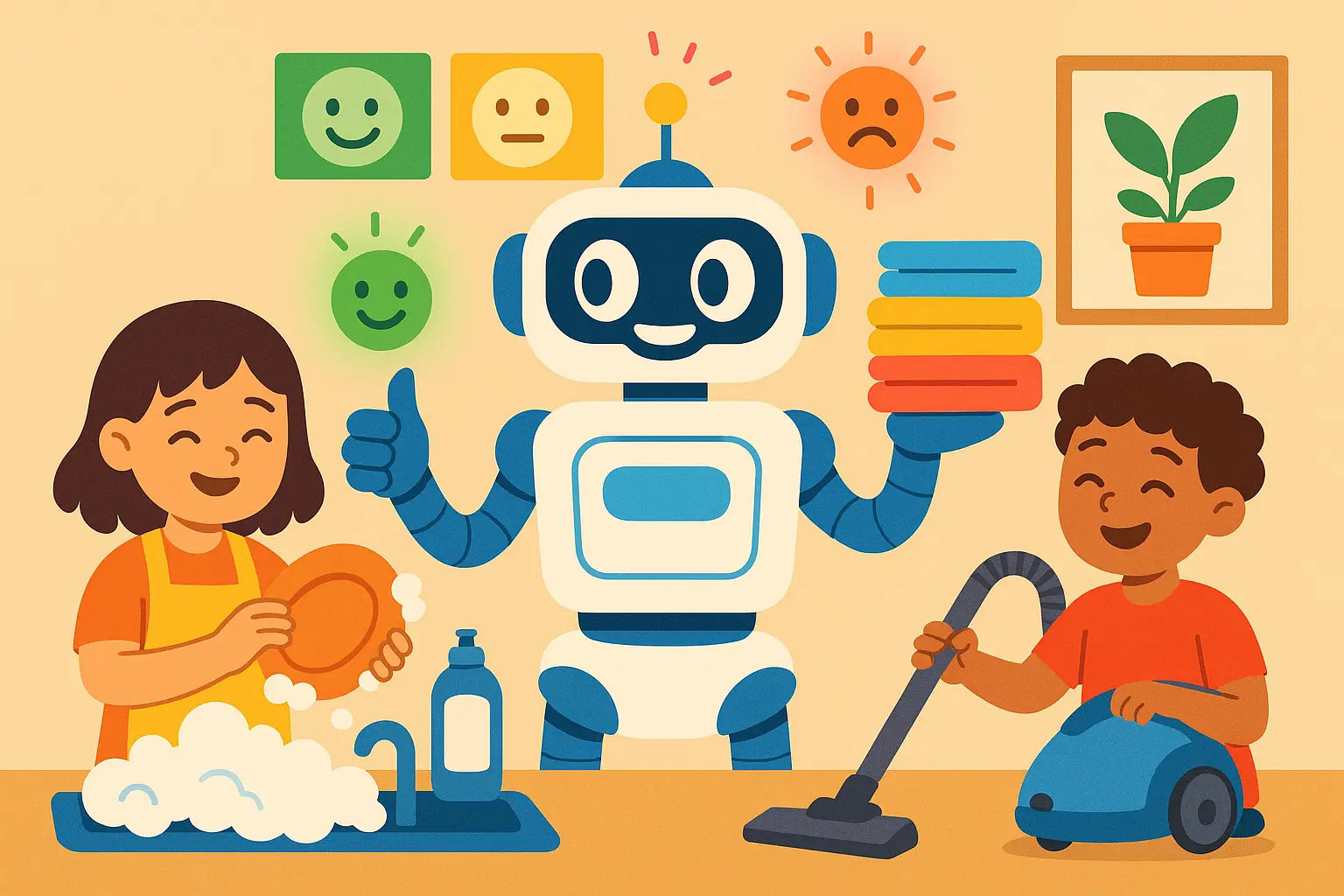
22. The Alien Exchange Student
A friendly alien attends Earth school but struggles with cultural differences, from eating habits to communication styles. The story follows both the alien’s adaptation and how human students learn to be more inclusive.
It’s a great way to teach acceptance and celebrating diversity while sneaking in basic astronomy and cultural anthropology. Kids learn about welcoming newcomers and understanding that different doesn’t mean wrong.
23. The Time Machine Malfunction
Children accidentally travel to different time periods when their science teacher’s experimental time machine goes haywire. They must work together using historical knowledge and problem-solving skills to repair the machine and return home safely.
It’s like a history textbook that actually keeps kids awake. They learn about different time periods while understanding how teamwork and diverse skills help solve complex problems.
24. The Space Station Mystery
Young astronauts living on a space station investigate strange occurrences – floating objects behaving oddly and mysterious sounds in the ventilation system. Their scientific investigation reveals natural space phenomena and teaches systematic problem-solving.
Kids learn space science and physics concepts about gravity and air pressure while developing the scientific method. It shows them how to approach mysteries with curiosity rather than fear.
25. The Parallel Universe Portal
Kids discover a doorway to an alternate version of their town where everything’s slightly different – their school’s a castle, pets can talk, and parents have different jobs. They must find their way home while learning to appreciate what they have.
This one explores identity and gratitude while teaching basic physics concepts about parallel dimensions. It’s the kind of story that has kids looking for secret portals in their own neighborhoods.
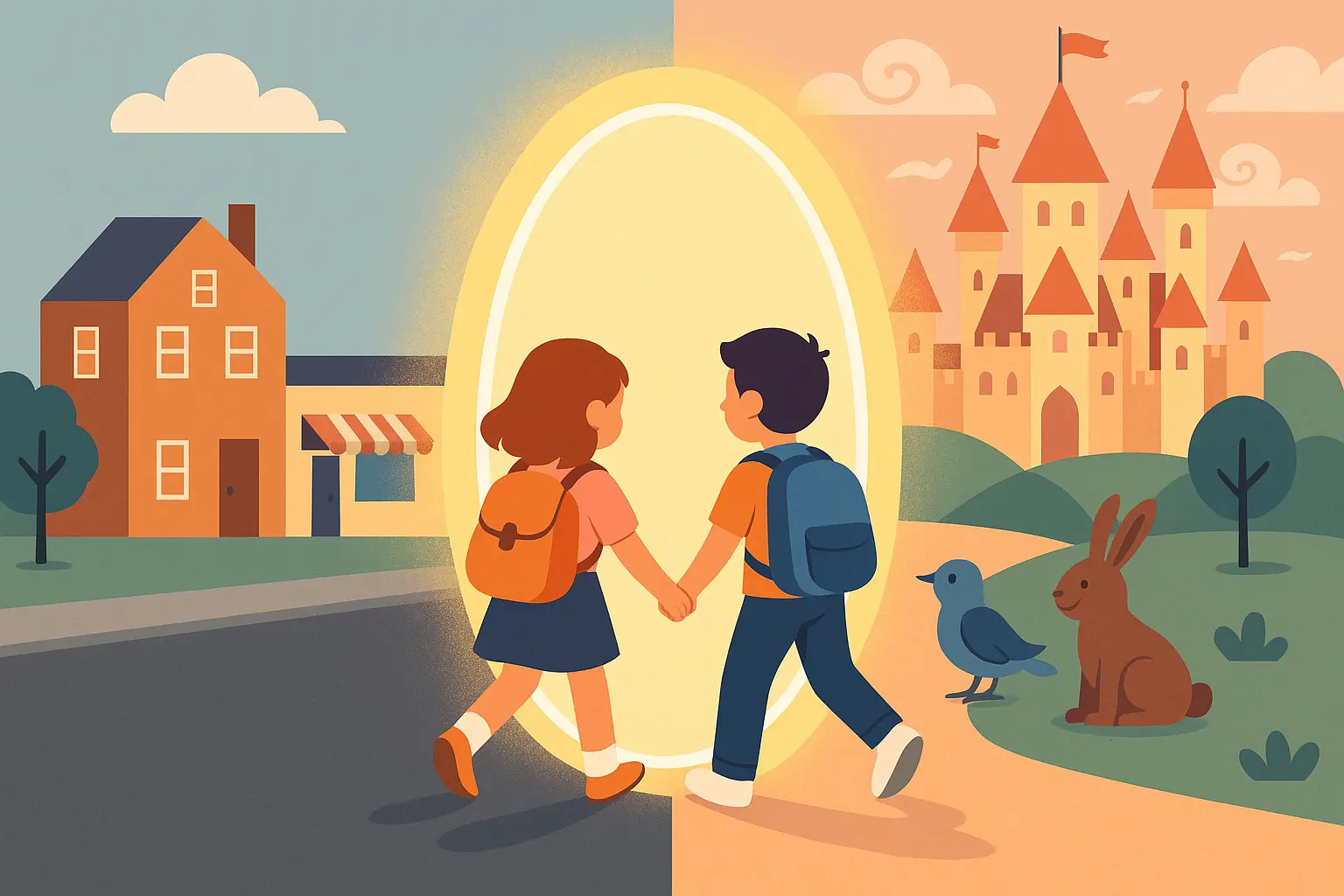
Spooky Tales from Around the World
Folk horror stories for kids 6-12 draw from different cultural traditions, presenting supernatural elements through folklore while maintaining age-appropriate content and respectful representation. These stories introduce children to diverse perspectives while teaching universal values.
These culturally diverse stories build on the rich tradition of folklore stories that have taught important life lessons across generations and cultures.
The key here is respecting different cultures while avoiding stereotypes. The best stories collaborate with cultural consultants and focus on universal themes while honoring specific traditions.
These tales often feature protective spirits, helpful magical creatures, and wise elders who guide young characters through challenges. The supernatural elements feel safely rooted in tradition rather than threatening, providing comfort through their connection to cultural wisdom.
A respectful adaptation might feature a helpful kappa (Japanese water spirit) who teaches children about water safety and environmental protection. The story includes cultural context about the kappa’s traditional role while focusing on positive lessons about respecting nature and helping others.
My Simple Test for Any Scary Story
When you’re trying to figure out if a horror story will work for your kid, here’s my practical approach that’s saved me from many bedtime disasters.
The Quick Parent Check
First, flip through and look for these green flags: Does it end happily? Are the scary elements clearly fantastical? Do characters solve problems through friendship and creativity rather than violence? If you’re nodding yes, you’re probably on the right track.
Red flags include: realistic dangers kids might actually encounter, graphic content of any kind, or endings that leave problems unresolved. If you find yourself thinking “this might give me bad dreams,” skip it.
Age-Appropriate Content Guidelines
For younger kids (6-10), look for stories with mild suspense and no genuinely frightening content. The supernatural elements should be clearly fantastical and non-threatening, with positive resolutions that reinforce safety and courage.
Older children (9-12) can handle psychological mystery with mild supernatural elements, provided threats remain non-violent and ultimately sympathetic. Problems should be solvable through empathy and community action.
Educational and Emotional Value
The best stories integrate life skills naturally into the narrative. Social lessons about sharing, understanding different perspectives, and building empathy should emerge organically rather than feeling forced.
Look for emotional growth opportunities that build self-confidence, teach coping strategies, and show characters overcoming challenges. These skills should be ones children can apply in their real lives.
Creating Custom Stories When You’re Out of Ideas
Stuck for bedtime story ideas? I get it. Sometimes you’ve read “Goodnight Moon” so many times you could recite it backwards. That’s where story generators can be a lifesaver.
For parents looking to create their own stories, Nairrate’s horror story generator and kids story generator provide excellent starting points for crafting age-appropriate scary tales.
Getting Started with AI Story Tools
These tools understand the delicate balance between excitement and safety, helping you generate content that thrills without frightening. Just plug in your kid’s age and interests – dinosaurs, space, friendly monsters – and you get custom stories actually appropriate for them.
AI-powered generators excel at creating supernatural characters that are more quirky than scary, helping develop monsters and ghosts that teach rather than terrorize. They automatically adjust language complexity and themes based on target age groups.
Supporting Young Writers
For kids who want to write their own horror stories, AI provides story starters that help overcome blank page anxiety while teaching story structure and character development. These tools offer safe ways for young writers to explore fears and emotions through fictional narratives.
Parents and educators can use AI-generated prompts to create classroom materials or bedtime stories that meet specific educational goals while maintaining the thrilling elements that keep children engaged with reading.
The technology also supports creating diverse characters and inclusive narratives that reflect modern values while respecting different cultural approaches to supernatural themes.
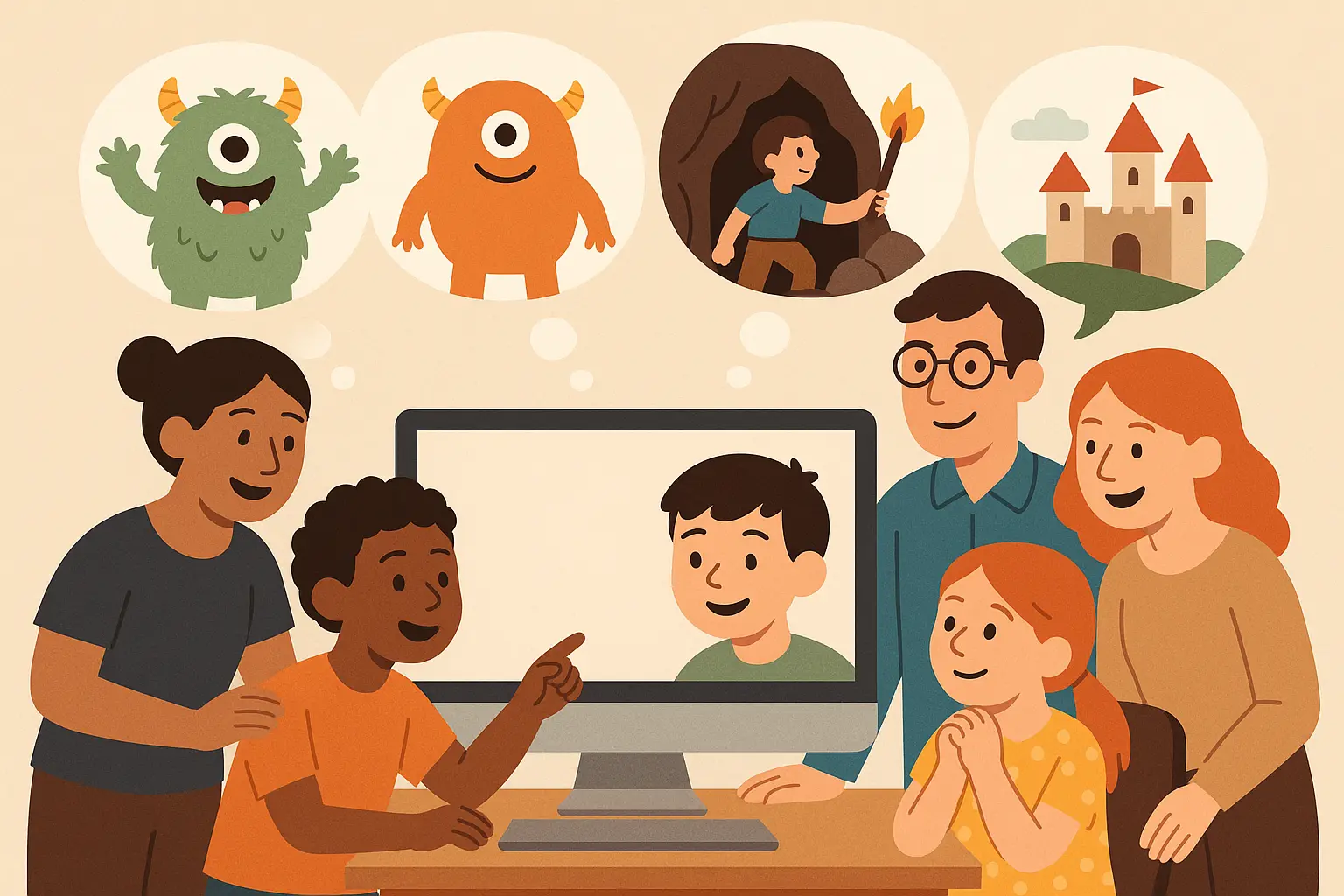
Final Thoughts
Here’s the truth: you’re going to mess this up sometimes. I once read a story about a “cute” spider that had my son convinced every spider in our house was plotting against him. But that’s okay! Kids are more resilient than we think, and honestly, those “oops” moments often become the funny family stories you laugh about later.
The point isn’t to be perfect – it’s to keep them reading, keep them curious, and maybe give them just enough goosebumps to make storytime exciting. The 25 stories I’ve shared here show how effective children’s horror can educate while entertaining, building emotional resilience and critical thinking skills through age-appropriate scares and positive messaging.
Remember that every child develops differently, so trust your gut about individual maturity levels and sensitivities. The goal isn’t to eliminate all fear from children’s reading experiences, but rather to provide controlled opportunities for them to explore emotions, develop coping strategies, and build confidence.
Whether you’re a parent seeking engaging bedtime stories, an educator looking for classroom materials, or a young writer ready to craft your own spooky tales, these principles offer a foundation for creating horror content that empowers rather than frightens. With the right approach, scary stories become powerful tools for helping children grow into brave, empathetic, and resilient individuals.
And hey, if they end up sleeping in your bed for a night or two? Well, they won’t be little forever.




Add comment